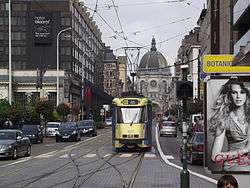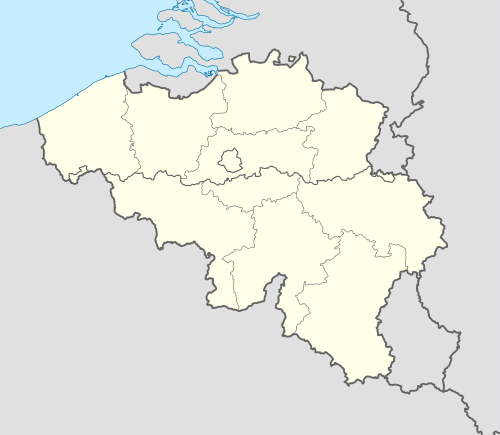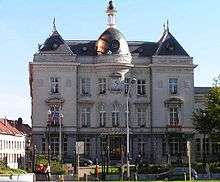Saint-Josse-ten-Noode
Saint-Josse-ten-Noode (French: [sɛ̃ ʒos ten nɔd]) or Sint-Joost-ten-Node (Dutch pronunciation: [sɪn ˈcoːst tɛn ˈnoːdə])[3] is one of the nineteen municipalities in the Brussels-Capital Region of Belgium. It is bordered by the City of Brussels and Schaerbeek.
Saint-Josse-ten-Noode | |
|---|---|
 | |
 Flag  Coat of arms | |
 Saint-Josse-ten-Noode Location in Belgium
Location of Saint-Josse-ten-Noode  | |
| Coordinates: 50°51′N 04°23′E | |
| Country | Belgium |
| Community | Flemish Community French Community |
| Region | Brussels |
| Arrondissement | Brussels |
| Government | |
| • Mayor | Emir Kir[1] |
| Area | |
| • Total | 1.14 km2 (0.44 sq mi) |
| Population (2018-01-01)[2] | |
| • Total | 27,032 |
| • Density | 24,000/km2 (61,000/sq mi) |
| Postal codes | 1210 |
| Area codes | 02 |
| Website | sjtn.brussels |
On 1 January 2007 the municipality had a total population of 23,785. The total area is 1.14 km² which gives a population density of 20,664 inhabitants per km². From a total of 581 municipalities in Belgium, Saint-Josse-ten-Noode is both the smallest in area size and the highest in population density. In common with all the Brussels municipalities, it is legally bilingual (French–Dutch).
History

Named after Judoc, Saint-Josse-ten-Noode was originally a farming village on the outskirts of Brussels. In the centuries before the dismantling of the ramparts encircling Brussels, Saint-Josse-ten-Noode was also the place where noblemen built country estates, the most notable amongst them the Castle of the Dukes of Brabant built by Philip the Good in 1456. The area surrounding that castle was planted with wine groves which explains the presence of the bushel of grapes in the coat of arms of the commune.[4]
After the demolition of the ramparts, Saint-Josse-ten-Noode was one of the first areas outside Brussels to urbanise. The rich built houses around the new boulevards and higher parts of the commune, while industries and workman's cottages were built in the lower lying part close to the River Zenne. In 1855, 58% of the land area of Saint-Joose-Ten-Noode was annexed by the municipality of the City of Brussels to make way for the Squares Ambiorix, Palmerston, Marie-Louise and Marguerite of the newly created Leopold Quarter (now the European Quarter).[4]
According to an inventory of architecture commissioned by the region of Brussels, Saint-Josse-ten-Noode has on average the oldest buildings of all 19 Brussels communes.[5]
Demographics
| Citizenship | 1979 | 1995 | 2007 | |||
|---|---|---|---|---|---|---|
| Belgium | 12,222 | 54.5% | 9,231 | 42.1% | 14,656 | 61.6% |
| Turkey | 2,304 | 10.3% | 3,904 | 18.1% | 1,527 | 6.4% |
| Morocco | 2,664 | 11.9% | 3,761 | 17.5% | 1,482 | 6.2% |
| France | ― | ― | ― | ― | 674 | 2.8% |
| Italy | 1,661 | 7.4% | 785 | 3.6% | 458 | 1.9% |
| Congo (DRC) | 198 | 0.9% | ― | ― | 453 | 1.9% |
| Poland | ― | ― | ― | ― | 432 | 1.8% |
| Romania | ― | ― | ― | ― | 387 | 1.6% |
| Spain | 840 | 3.7% | 443 | 2.1% | 317 | 1.3% |
| Bulgaria | ― | ― | ― | ― | 251 | 1.1% |
| Total pop. | 22,409 | 21,522 | 23,785 | |||
While foreigners were a majority in 1995, in 2007 most of the population had Belgian citizenship, which has resulted in a sharp increase of municipal councillors with a foreign background, benefitting from the open proportional electoral system: from none in 1988 to two (from Morocco) in 1994, a near majority of 13 (seven from Morocco, five from Turkey) out of 27 in 2000 (including three aldermen) and a majority of 20 out of 27[7] in 2007 (including six aldermen out of seven, the seventh is a member of the Flemish minority[8]).
List of mayors
From: Histoire de Saint Josse Ten Noode et de Schaerbeek – Van Bemmel – 1869 and other sources available at the local public library.
- André-Etienne-Joseph O'Kelly 1800–1808
- Jacques-Joseph De Glimes (GLIM) 1808 to July 1813
- Théodore-Nicolas-Joseph Aerts 1813
- Jean-François Wauvermans 1813–1823
- Urbain Henri Verbist 1823–1842
- Léonard Constant Willems 29 December 1842 – 1846
- Jacques Joseph Damas Gillon 18 April 1846 – 1867
- Louis Guillaume Felix Sainctelette 13 February 1867
- Fritz Jottrand 1870–1884
- Armand Steurs 1885–1899
- Henri Frick 1900–1926
- Georges Petre 1926–1942 alderman, then mayor from 1926 until his destitution and assassination by the Rexists in 1942)
- Joseph Dery 1944–1947
- André Saint-Remi 1947–1953
- Guy Cudell 1953–1999
- Jean Demannez 1999–2012 (councillor in 1976, alderman in 1977, mayor since 1999, reelected in 2000 and 2006)
- Emir Kir 2012–present
Culture
Charlier Museum is devoted to Belgian art of the end of the 19th century.[9] The Jazz Station is a museum and archive on jazz, and a venue for jazz concerts.[10]
References
- De Standaard (16 October 2012). "Emir Kir wordt burgemeester van Sint-Joost-ten-Node". De Standaard. Retrieved 18 October 2012.
- "Wettelijke Bevolking per gemeente op 1 januari 2018". Statbel. Retrieved 9 March 2019.
- The first two words in isolation: [sɪnt ˈjoːst].
- "Site officiel de la Commune de Saint-Josse-ten-Noode". irisnet.be.
- "Archived copy". Archived from the original on 17 May 2011. Retrieved 6 August 2013.CS1 maint: archived copy as title (link)
- Institut National de Statistiques
- Conseil communal, Commune de Saint-Josse-ten-Noode, retrieved 2 October 2009
- including alderman Eric Jassin, of mixed Belgian-Moroccan parentage Collège des Bourgmestre et Echevins, Commune de Saint-Josse-ten-Noode, retrieved 2 October 2009
- "Charlier Museum" (in Dutch). Charlier Museum. Retrieved 30 May 2016.
- Bruzz, Het ABC van Jean Demannez, 22 September 2015 (in Dutch)
External links
| Wikimedia Commons has media related to Saint-Josse-ten-Noode. |
- Saint-Josse-ten-Noode (in French and Dutch)
